- NEWS FEATURE
- Correction 22 August 2023
Europe spent €600 million to recreate the human brain in a computer. How did it go?
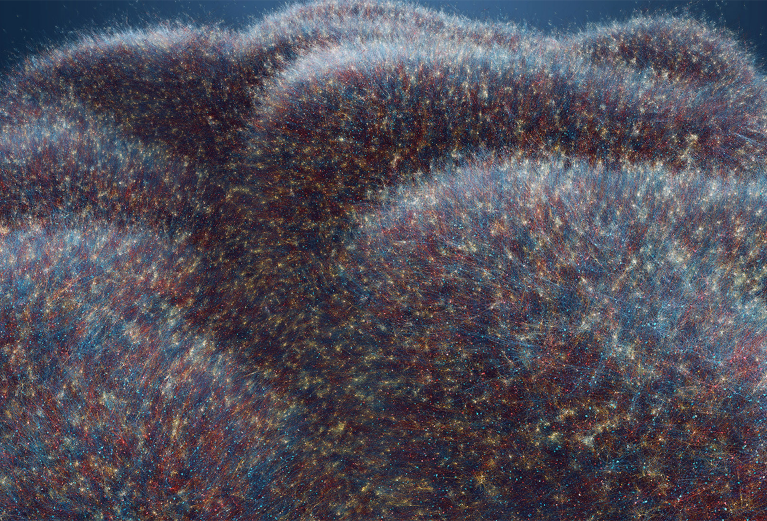
Digital reconstruction of a circuit of neurons from the temporal lobe of a human brain. Credit: Nicolas Antille
It took 10 years, around 500 scientists and some €600 million, and now the Human Brain Project — one of the biggest research endeavours ever funded by the European Union — is coming to an end. Its audacious goal was to understand the human brain by modelling it in a computer.
During its run, scientists under the umbrella of the Human Brain Project (HBP) have published thousands of papers and made significant strides in neuroscience, such as creating detailed 3D maps of at least 200 brain regions1, developing brain implants to treat blindness2 and using supercomputers to model functions such as memory and consciousness and to advance treatments for various brain conditions3.
“When the project started, hardly anyone believed in the potential of big data and the possibility of using it, or supercomputers, to simulate the complicated functioning of the brain,” says Thomas Skordas, deputy director-general of the European Commission in Brussels.
Almost since it began, however, the HBP has drawn criticism. The project did not achieve its goal of simulating the whole human brain — an aim that many scientists regarded as far-fetched in the first place. It changed direction several times, and its scientific output became “fragmented and mosaic-like”, says HBP member Yves Frégnac, a cognitive scientist and director of research at the French national research agency CNRS in Paris. For him, the project has fallen short of providing a comprehensive or original understanding of the brain. “I don’t see the brain; I see bits of the brain,” says Frégnac.
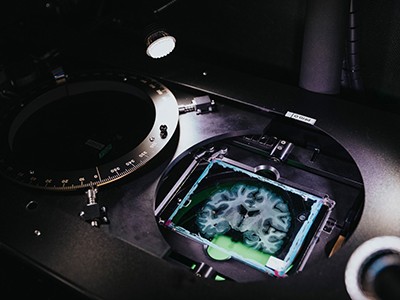
How the world’s biggest brain maps could transform neuroscience
HBP directors hope to bring this understanding a step closer with a virtual platform — called EBRAINS — that was created as part of the project. EBRAINS is a suite of tools and imaging data that scientists around the world can use to run simulations and digital experiments. “Today, we have all the tools in hand to build a real digital brain twin,” says Viktor Jirsa, a neuroscientist at Aix-Marseille University in France and an HBP board member.
But the funding for this offshoot is still uncertain. And at a time when huge, expensive brain projects are in high gear elsewhere, scientists in Europe are frustrated that their version is winding down. “We were probably one of the first ones to initiate this wave of interest in the brain,” says Jorge Mejias, a computational neuroscientist at the University of Amsterdam, who joined the HBP in 2019. Now, he says, “everybody’s rushing, we don’t have time to just take a nap”.
Chequered past
The HBP was controversial from the start. When it launched in 2013, one of its key aims was to develop the tools and infrastructure required to better understand the function and organization of the brain and its diseases, alongside smaller projects in basic and clinical neuroscience. It was one of two long-term research programmes awarded funds that year that were intended to boost industry in Europe; the other was a project to study the potential of graphene.
The HBP was promised €1 billion (US$1.1 billion) in funds. In the end, it received €607 million, including €406 million from the EU, released over four phases and trickled out to labs that competed for grants at each phase (see ‘How the Human Brain Project evolved’).
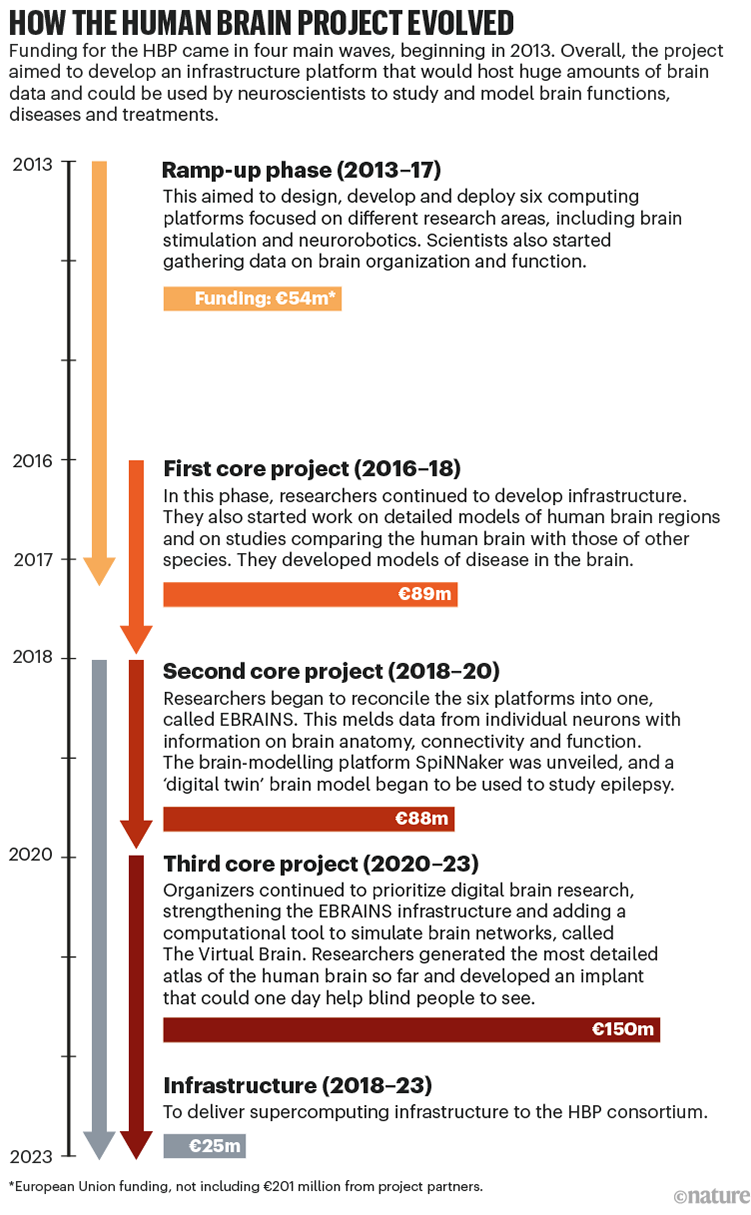
But in the first year, the HBP ran into trouble. Founder and former director, neuroscientist Henry Markram at the Swiss Federal Institute of Technology in Lausanne (EPFL), said that the HBP would be able to reconstruct and simulate the human brain at a cellular level within a decade. Markram’s assertions sparked widespread scepticism from neuroscientists. “When science charts a new course, controversy naturally follows,” says Markram.
The lofty goal might have helped the HBP to get off the ground, says Timothy O’Leary, a computational neuroscientist at the University of Cambridge, UK, who is not part of the HBP. “It’s not clear that the HBP would have got funded without some kind of ridiculously ambitious goal attached to it.”
Over time, Markram’s leadership became increasingly unpopular. In 2014, he and the other two members of the executive committee changed the focus of the project, cutting out a swathe of research on cognitive neuroscience that resulted in a network of 18 laboratories leaving the project. Markram says that there was dispute over funding for the various arms. In response, more than 150 scientists signed a protest letter, urging the European Commission to reconsider the HBP’s purpose in time for the second round of funding. The letter said that the HBP was poorly managed and had partly run off its scientific course. “It became evident that some in the neuroscience community were not ready to be united under a single vision,” Markram says.
The EU formed a committee of independent specialists to look at how the project was being run and to revise its scientific objectives. The committee recommended that the HBP should re-evaluate and more sharply articulate its scientific goals, as well as re-integrate cognitive and systems neurosciences into its core programme. In February 2015, the HBP’s board of directors voted to disband the three-person executive committee and replace it with a larger board.
The tumult made some scientists wary of the project. “This scepticism kept dragging a little bit,” says Mejias.
Meanwhile, large brain projects launched or kicked into high gear elsewhere. The United States and Japan both launched brain projects around the same time as the HBP — the former will continue until 2026 and the latter is hoping to run for a total of 15 years. China’s brain project started in 2021, and Australia’s and South Korea’s projects have both entered their seventh year.
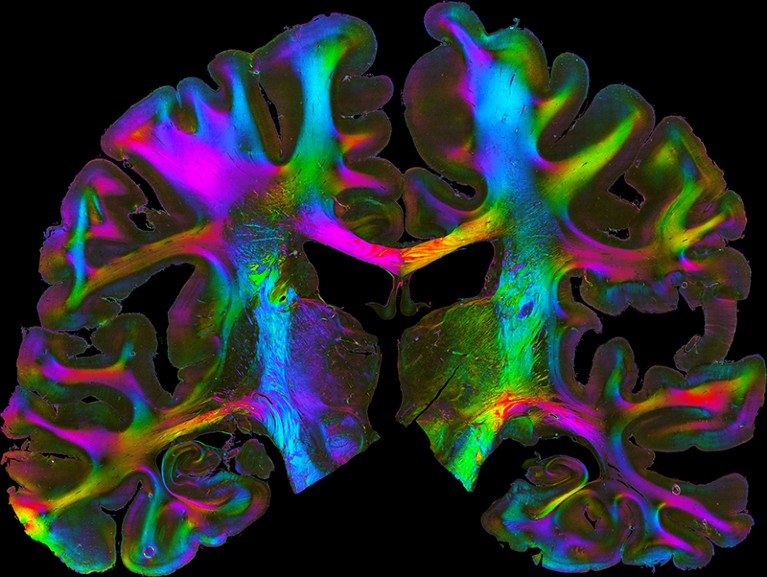
A slice of a human brain showing the architecture of fibres connecting different regions.Credit: Markus Axer and Katrin Amunts, INM-1, Forschungszentrum Jülich
The HBP’s drama did not end with the removal of the executive committee. Between 2016 and 2020, there were several changes to the upper echelons of the project’s management. Meanwhile, the science began to pick up speed. In 2016, as a result of the project’s development phase, the HBP launched six specialized operating platforms, covering areas such as brain simulations, high-performance analytics and computing, and neurorobotics.
The idea was to integrate the six strands as time went on, but in the beginning, “they were rather independent”, says Katrin Amunts, a neuroscientist at Research Centre Jülich in Germany and scientific research director of the HBP. “Having such a big project like HBP means that there is a learning process, not everything works from the very beginning,” she says.
Greatest hits
Management aside, the HBP has stacked up some important and useful science. By creating and combining 3D maps of around 200 cerebral-cortex and deeper brain structures, HBP scientists made the Human Brain Atlas, which is accessible through EBRAINS. The atlas depicts the multilevel organization of the brain, from its cellular and molecular architecture to its functional modules and connectivity.
“The Human Brain Atlas is a little bit like Google Maps, but for the brain,” said Amunts during a press briefing at the HBP Summit 2023 in March.

The atlas used post-mortem brain data to generate standardized maps, accounting for natural variability between people. Using the atlas, HBP scientists have identified six previously unknown brain regions in the prefrontal cortex that contribute to memory, language, attention and music processing4. It also links its maps to gene-expression data in the Allen Human Brain Atlas, a database developed by the Allen Institute for Brain Science in Seattle, Washington, that characterizes neurons across the brain. Using the paired atlases, researchers revealed how changes in gene expression associated with depression were linked to structural and functional changes in a region of the frontal cortex5.
HBP researchers have also developed unique algorithms that can build a full-scale scaffold model of brain regions from microscopy images. Using this tool, researchers have produced a detailed map of the CA1 region in the hippocampus, an area that is important for memory. The map contains around 5 million neurons and 40 billion synapses6.
The HBP has translated some findings into clinical applications, using personalized models of the brain — or ‘digital twins’ — to improve treatments for epilepsy3 and Parkinson’s disease7. Digital twins are mathematical representations of a person’s brain that merge scans from an individual with a model, explains Jirsa.
Jirsa and his colleagues launched a clinical trial called EPINOV in June 2019, to test whether digital models built using brain-scan data can help to identify the origin of seizures and improve the success rate of surgery for epilepsy. This is “something I would not have been able to do outside of EBRAINS,” says Jirsa.
The EPINOV trial has recruited 356 people across 11 French hospitals. Jirsa hopes to make the imaging data from the trial available to other researchers through EBRAINS.
The original project plan for the HBP included the development of computing systems modelled on the brain. HBP scientists have contributed to neural networks that can simulate large brain-like systems, either to test ideas about how brains work or to control other hardware, such as robots or smartphones8.
Not the whole picture
The project’s organizers and critics cite a common thread running through the HBP: fragmentation. This is a long-standing issue in neuroscience research. “I see very astute applications, but you don’t see multiscale integration, and you don’t see the big problems being tackled,” says Frégnac.
In its last three years, the HBP has tried to overcome the fragmentation of its interdisciplinary sub-projects by knitting together their technologies into EBRAINS. Initiatives across the HBP’s six platforms started to develop compatible tools and shared data standards, and some groups were re-organized to centre on particular scientific challenges rather than disciplines. “But there is a lot of work to be done,” says Jirsa. “Neurorobotics [still] has zero link to the more clinically driven group.”
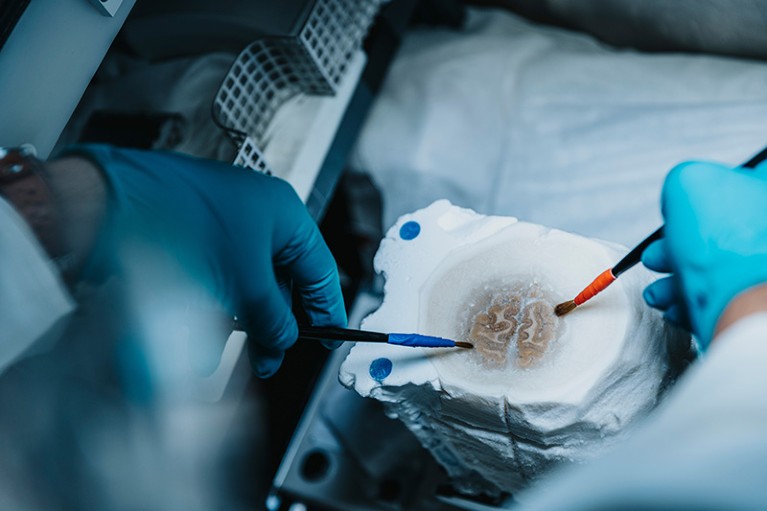
The HBP has characterized human brain anatomy in fine detail, and developed tools to link brain structure and function to gene expression.Credit: Mareen Fischinger
For some researchers, the fragmented scientific outcomes of the HBP stem from a lack of focus. “A project that lasts over ten years, I would expect it to produce a conceptual breakthrough,” says Fred Wolf, a theoretical neurophysicist at the University of Göttingen, Germany, who left the HBP after signing the open letter. But that wasn’t the case for the HBP, he says.
David Hansel, a neuroscientist at the Integrative Neuroscience and Cognition Center in Paris, who wasn’t part of the project, says the HBP’s lack of prioritization and limited collaboration meant that it failed to capitalize on its size and to really unite the neuroscience community behind a common goal. “It did not have a list of top and reasonable questions to address. Basically, the ‘goal’ was to understand the brain.”
John Ngai, director of the US National Institutes of Health’s Brain Research Through Advancing Innovative Neurotechnologies (BRAIN) Initiative in Bethesda, Maryland, which focuses on developing tools to catalogue, monitor and measure the brain, thinks that an emphasis on data gathering rather than hypothesis-driven science is defensible. “Big science is not always about moonshots, especially when the steps toward major goals are uncertain.”
The legacy
At the end of September, the HBP will cease to give out funds. Although some endeavours that emerged from the project have already secured grants to continue their work, the future is uncertain for many researchers who have worked partly or fully with the HBP.
But Amunts and others hope that the HBP’s work and the EBRAINS platform will be a foundation for European neuroscience for years to come. “Research on the brain requires an understanding of the multilevel and multiscale of the brain,” says Amunts.
In January 2018, the HBP was awarded €50 million, including €25 million from the EU, to develop interactive supercomputing tools and data-storage services for EBRAINS.

Researchers are already using the platform to see how the brain might respond to stimulation, for example, and to develop brain-mimicking robots. Ngai says that the HBP’s pivot to EBRAINS has produced a valuable tool. Similar platforms exist elsewhere, but they lack the scale and services provided by EBRAINS.
In March, the European Commission turned down an application for €38 million to keep EBRAINS running, but reopened the same funding call in June after negotiating with the HBP, giving the team another opportunity to apply. If unsuccessful, the platform will rely on a combination of private funding and financial support from individual EU countries.
Meanwhile, the European Commission is preparing to take stock. The project’s final review will begin in November and is expected to be published in January 2024. “If we don’t want to live the equivalent of the AI winter in global neuroscience, we need to make it respectable. We need really to evaluate if this type of flagship initiative has been good or not,” says Frégnac.
The end of the HBP is not the end of neuroscience in Europe, however, says Pawe? ?wieboda, chief executive of EBRAINS and director-general of the HBP.
The European Commission and member states are planning the next phase of Europe’s brain-health research, which will focus on using personalized brain models to advance drug discovery and improve treatments for brain disorders.
But researchers say that future projects will need to avoid the struggles that plagued the HBP. “We don’t want to do another HBP as it was in the beginning,” says O’Leary. “We need to support small scale, focused science as well as ambitious integrated projects.”
Ultimately, the mega-project did create communities of scientists focused on some common goals, he says. “That’s an enduring legacy.”
Nature 620, 718-720 (2023)
doi: https://doi.org/10.1038/d41586-023-02600-x
UPDATES & CORRECTIONS
-
Correction 22 August 2023: An earlier version of this News feature gave the wrong credits for the image of the digital reconstruction of a neuronal circuit and the polarized-light image of the brain.
References
-
Amunts, K. et al. Science 369, 988–992 (2020).